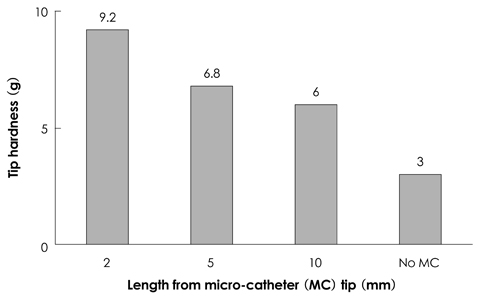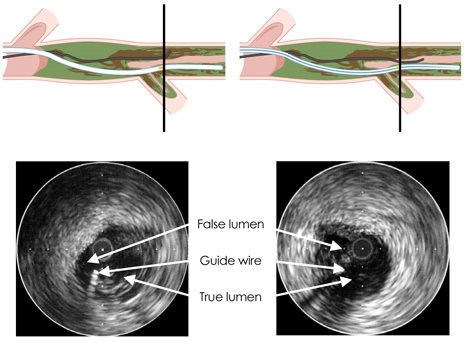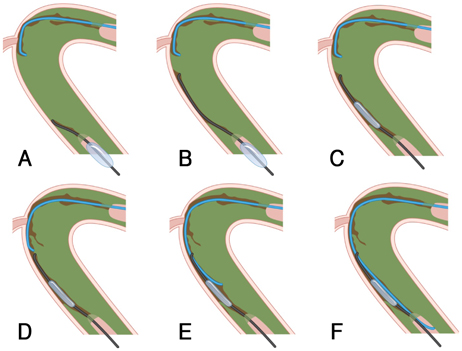Korean Circ J.
2010 May;40(5):209-215. 10.4070/kcj.2010.40.5.209.
Percutaneous Recanalization of Coronary Chronic Total Occlusions: Current Devices and Specialized Wire Crossing Techniques
- Affiliations
-
- 1Division of Cardiology, Department of Internal Medicine, College of Medicine, The Catholic University of Korea, Bucheon, Korea. cumckhy@catholic.ac.kr
- KMID: 1456363
- DOI: http://doi.org/10.4070/kcj.2010.40.5.209
Abstract
- Treatment of coronary chronic total occlusions (CTOs) remains a challenging obstacle, posing a considerable barrier to achieving successful complete revascularization. By nature of their complexity, percutaneous CTO interventions are associated with lower rates of procedural success, higher complication rates, greater radiation exposure and longer procedure times compared with non-CTO interventions. In the last few years, development in guidewires, devices and the emergence of new techniques from Japanese centers resulted in higher success rates in the hands of experienced operators. The impact of drug eluting stents on restenosis has improved long-term outcomes after successful recanalization. Successful revascularization is associated with improved long-term survival, reduced symptoms, improved left ventricular function and reduced need for coronary bypass surgery. This paper reviews the current devices and specialized crossing techniques of percutaneous intervention to relieve CTOs.
Keyword
MeSH Terms
Figure
Reference
-
1. Park CS, Kim HY, Park HJ, et al. Clinical, electrocardiographic, and procedural characteristics of patients with coronary chronic total occlusions. Korean Circ J. 2009. 39:111–115.2. Christofferson RD, Lehmann KG, Martin GV, Every N, Caldwell JH, Kapadia SR. Effect of chronic total coronary occlusion on treatment strategy. Am J Cardiol. 2005. 95:1088–1091.3. Anderson HV, Shaw RE, Brindis RG, et al. A contemporary overview of percutaneous coronary interventions: the American College of Cardiology-National Cardiovascular Data Registry (ACC-NCDR). J Am Coll Cardiol. 2002. 39:1096–1103.4. Williams DO, Holubkov R, Yeh W, et al. Percutaneous coronary intervention in the current era compared with 1985-1986: the National Heart, Lung, and Blood Institute Registries. Circulation. 2000. 102:2945–2951.5. Sirnes PA, Myreng Y, Molstad P, Bonarjee V, Golf S. Improvement in left ventricular ejection fraction and wall motion after successful recanalization of chronic coronary occlusions. Eur Heart J. 1998. 19:273–281.6. Suero JA, Marso SP, Jones PG, et al. Procedural outcomes and long-term survival among patients undergoing percutaneous coronary intervention of a chronic total occlusion in native coronary arteries: a 20-year experience. J Am Coll Cardiol. 2001. 38:409–414.7. Olivari Z, Rubartelli P, Piscione F, et al. Immediate results and one-year clinical outcome after percutaneous coronary interventions in chronic total occlusions: data from a multicenter, prospective, observational study (TOAST-GISE). J Am Coll Cardiol. 2003. 41:1672–1678.8. Werner GS, Emig U, Mutschke O, Schwarz G, Bahrmann P, Figulla HR. Regression of collateral function after recanalization of chronic total coronary occlusions: a serial assessment by intracoronary pressure and Doppler recordings. Circulation. 2003. 108:2877–2882.9. Zidar FJ, Kaplan BM, O'Neill WW, et al. Prospective, randomized trial of prolonged intracoronary urokinase infusion for chronic total occlusions in native coronary arteries. J Am Coll Cardiol. 1996. 27:1406–1412.10. Di Mario C, Werner GS, Sianos G, et al. European perspective in the recanalisation of Chronic Total Occlusions (CTO): consensus document from the EuroCTO Club. EuroIntervention. 2007. 3:30–43.11. Rathore S, Hakeem A, Pauriah M, Roberts E, Beaumont A, Morris JL. A comparison of the transradial and the transfemoral approach in chronic total occlusion percutaneous coronary intervention. Catheter Cardiovasc Interv. 2009. 73:883–887.12. Kim JY, Yoon JH, Jung HS, et al. The experience of transradial coronary intervention for chronic total occlusion. Korean Circ J. 2003. 33:805–812.13. Tan KH, Sulke N, Taub NA, Watts E, Karani S, Sowton E. Determinants of success of coronary angioplasty in patients with a chronic total occlusion: a multiple logistic regression model to improve selection of patients. Br Heart J. 1993. 70:126–131.14. Hirokami M, Saito S, Muto H. Anchoring technique to improve guiding catheter support in coronary angioplasty of chronic total occlusions. Catheter Cardiovasc Interv. 2006. 67:366–371.15. Rathore S, Terashima M, Suzuki T. Value of intravascular ultrasound in the management of coronary chronic total occlusions. Catheter Cardiovasc Interv. 2009. 74:873–878.16. Singh M, Bell MR, Berger PB, Holmes DR Jr. Utility of bilateral coronary injections during complex coronary angioplasty. J Invasive Cardiol. 1999. 11:70–74.17. Kawamura A, Jinzaki M, Kuribayashi S. Percutaneous revascularization of chronic total occlusion of left anterior descending artery using contralateral injection via isolated conus artery. J Invasive Cardiol. 2009. 21:E84–E86.18. Srivatsa S, Holmes D Jr. The histopathology of angiographic chronic total coronary artery occlusions N changes in neovascular pattern and intimal plaque composition associated with progressive occlusion duration. J Invasive Cardiol. 1997. 9:294–301.19. Carlino M, Latib A, Godino C, Cosgrave J, Colombo A. CTO recanalization by intraocclusion injection of contrast: the microchannel technique. Catheter Cardiovasc Interv. 2008. 71:20–26.20. Saito S. Waksman R, Saito S, editors. Wire control handling technique. Chronic Total Occlusions. 2009. 1st ed. West Sussex: Wiley-Blackwell;88–90.21. Saito S, Tanaka S, Hiroe Y, et al. Angioplasty for chronic total occlusion by using tapered-tip guidewires. Catheter Cardiovasc Interv. 2003. 59:305–311.22. Mitsudo K, Yamashita T, Asakura Y, et al. Recanalization strategy for chronic total occlusions with tapered and stiff-tip guidewire. J Invasive Cardiol. 2008. 20:571–577.23. Rathore S, Matsuo H, Terashima M, et al. Procedural and in-hospital outcomes after percutaneous coronary intervention for chronic total occlusions of coronary arteries 2002 to 2008: impact of novel guidewire techniques. JACC Cardiovasc Interv. 2009. 2:489–497.24. Surmely JF, Suzuki T. Waksman R, Saito S, editors. Parallel-wire techniquse. Chronic Total Occlusions. 2009. 1st ed. West Sussex: Wiley-Blackwell;83–85.25. Matsubara T, Murata A, Kanyama H, Ogino A. IVUS-guided wiring technique: promising approach for the chronic total occlusion. Catheter Cardiovasc Interv. 2004. 61:381–386.26. Rathore S, Terashima M, Suzuki T. Value of intravascular ultrasound in the management of coronary chronic total occlusions. Catheter Cardiovasc Interv. 2009. 74:873–878.27. Werner GS, Diedrich J, Schlz KH, Knies A, Kreuzer H. Vessel reconstruction in total coronary occlusions with a long subintimal wire pathway: use of muiltiple stents under guidance of intravascular ultrasound. Cathet Cardiovasc Diagn. 1997. 40:46–51.28. Rathore S, Katoh O, Matsuo H, et al. Retrograde percutaneous recanalization of chronic total occlusion of the coronary arteries: procedural outcomes and predictors of success in contemporary practice. Circ Cardiovasc Interv. 2009. 2:124–132.29. Werner GS, Ferrari M, Heinke S, et al. Agiographic assessment of collateral connections in comparison with invasively determined collateral function in chronic coronary occlusions. Circulation. 2003. 107:1972–1977.30. Surmely JF, Katoh O, Tsuchikane E, Nasu K, Suzuki T. Coronary septal collaterals as an access for the retrograde approach in the percutaneous treatment of coronary chronic total occlusions. Catheter Cardiovasc Interv. 2007. 69:826–832.31. Kimura M, Katoh O, Tsuchikane E, et al. The efficacy of a bilateral approach for treating lesions with chronic total occlusions the CART (controlled antegrade and retrograde subintimal tracking) registry. JACC Cardiovasc Interv. 2009. 2:1135–1141.
- Full Text Links
- Actions
-
Cited
- CITED
-
- Close
- Share
- Similar articles
-
- Percutaneous Transluminal Coronary Angioplasty in Total Coronary Artery Occlusion
- Results of percutaneous transluminal coronary angioplasty of chronic total occlusion.
- Interventional Management of “Balloon-Uncrossable†Coronary Chronic Total Occlusion: Is There Any Way Out?
- A Technical Focus on Antegrade Dissection and Re-entry for Coronary Chronic Total Occlusions: a Practice Update for 2019
- A case of arteriovenous fistula with drainage into the coronary sinus during the percutaneous tranluminal coronary angioplasty of chronic total occlusion of circumflex coronary artery




